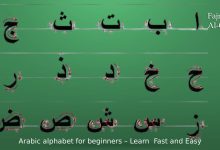Arabic Alphabet in English: Learn with Fajr Al-Quran Academy
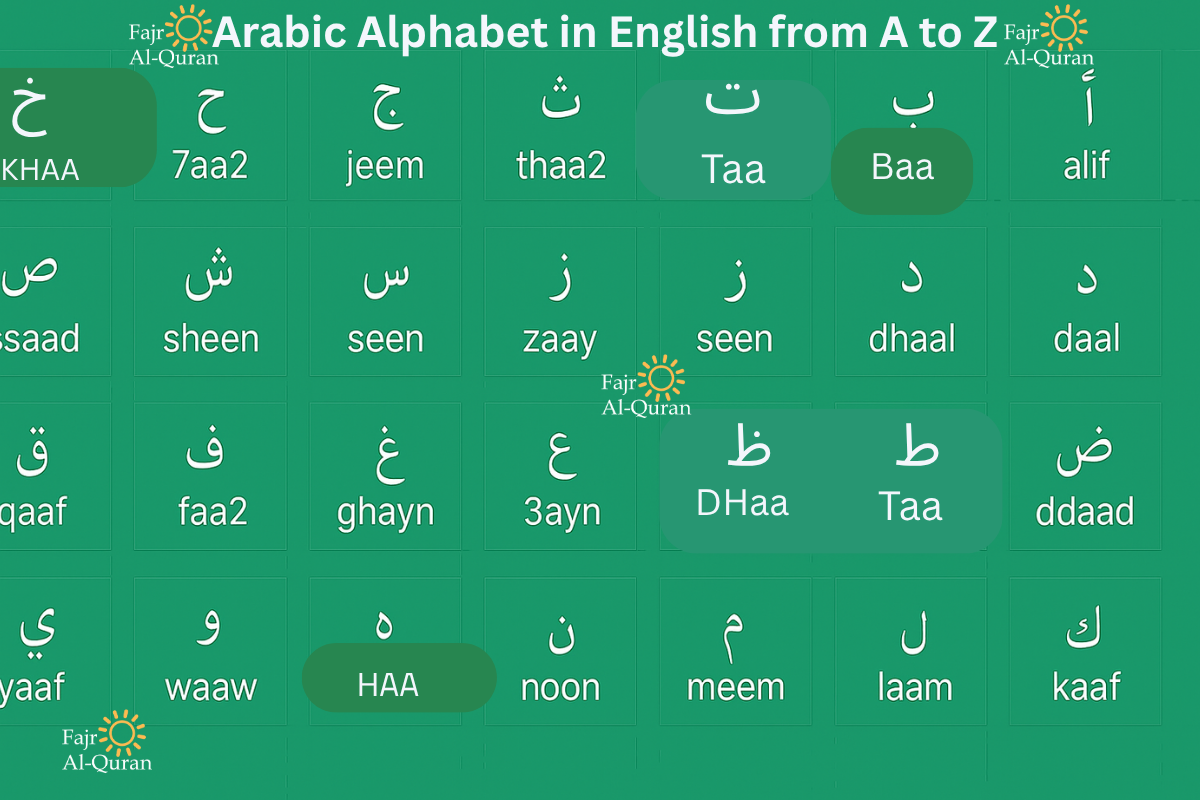
The Arabic alphabet in English refers to representing Arabic letters using English characters and transliterations.
The Arabic alphabet consists of 28 letters, written right to left, with unique sounds expressed using English letters and numbers in learning systems.
It is used for writing Arabic and several other languages.
Each letter appears differently depending on its position.
Some sounds, like “خ” (kh) or “ع” (‘ayn), don’t exist in English, making pronunciation challenging for learners.
Mastering these letters is essential for reading and writing Arabic accurately.
Arabic has a rich history and a captivating script that is both artistic and systematic.
For many English speakers, learning the Arabic alphabet letters might seem like a complex task.
But with the right guidance and structured lessons, it becomes an enriching journey.
At Fajr Al-Quran Academy, a leading platform for Arabic and Quranic education, learners from around the world are now mastering the Arabic alphabet in English using structured, interactive.
This guide is designed to introduce you to the Arabic alphabet in English step by step.
Using English transliteration, translation, pronunciation tips, and practical examples.
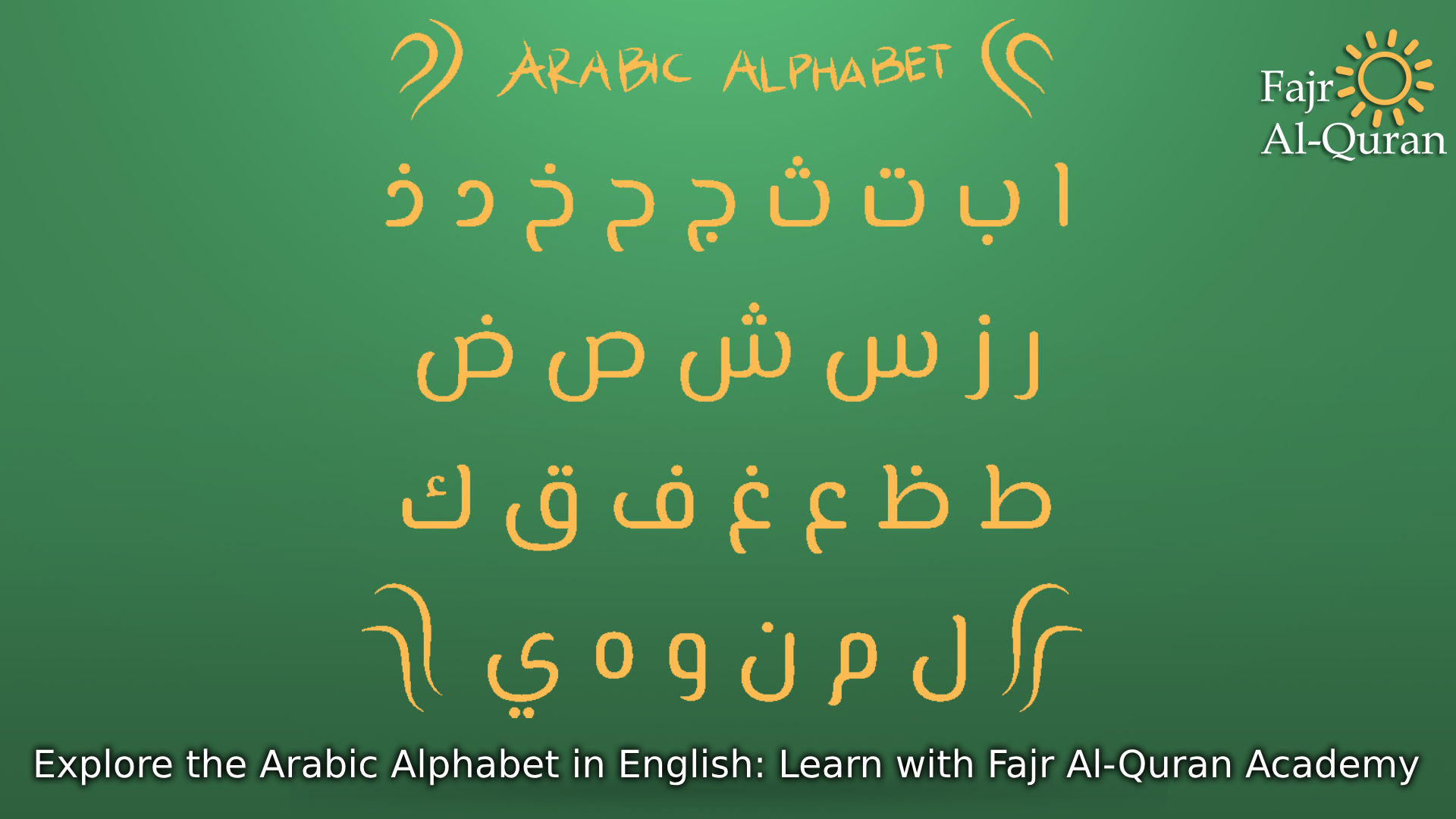
Understanding the Arabic Alphabet in English
To begin with, the Arabic alphabet is written from right to left, which differs from English and many other languages are written in a left-to-right direction.
There are 28 letters in the alphabet, ranging from the letter Hamza ( ء ) to Yaa ( ي ).
This change in direction is one of the first things learners notice.
The alphabet consists of 28 letters, many of which can take different forms depending on their position in initial, medial, final, or isolated.
Unlike English letters, where both vowels and consonants are represented equally.
Arabic places more emphasis on consonants, and the vowels are usually short and marked with diacritical signs.
These are often omitted in everyday writing, especially once fluency is reached.
However, learning the placement of these vowels is crucial in the early learning stages.
Arabic Alphabet in English in Order
The Arabic alphabet in English follows a traditional order known as the abjadiyah.
Arabic alphabet order letters are as follows:
Alif, Baa, Taa, Tha, Jeem, Haa, Khaa, Daal, Dhaal, Raa, Zay, Seen, Sheen, Saad, Daad, Taa (ط), Zaa (ظ), Ain, Ghain, Faa, Qaaf, Kaaf, Laam, Meem, Noon, Haa, Waaw, Yaa.
Each letter has a unique form, and many learners find it helpful to compare the Arabic alphabet in English characters with their equivalents for better understanding.
Arabic alphabet in English, for instance:
Alif (ا) – similar in structure to the English ‘A’
Baa (ب) – comparable to the letter ‘B’
Jeem (ج) – somewhere between ‘J’ and soft ‘G’
Khaa (خ) – a voiceless, constricted, fricative sound, unfamiliar in English
Fajr Al-Quran Academy provides Arabic-speaking classes, downloadable sheets, and audio guides to help with letter recognition and the formation of each basic character.
Arabic Alphabet in English Pronunciation
When we talk about pronunciation, we must recognize that some sounds in Arabic do not have direct English equivalents.
This makes transliteration extremely important.
Transliteration is the method of using English letters to represent Arabic sounds, allowing learners to pronounce Arabic even before they learn to read the actual script.
Let’s look at some examples:
Tha (ث) is pronounced like the ‘th” in “think”.
Dhaal (ذ) is like the ‘th’ in “that”.
Qaaf (ق) is a deeper ‘k’ sound, produced further back in the throat.
Ain (ع) is a constricted sound with no English alphabet equivalent.
At Fajr Al-Quran Academy, students use audio lessons to master these unique sounds.
Alongside a transliteration system based on Latin characters, it helps English readers mimic with ease.
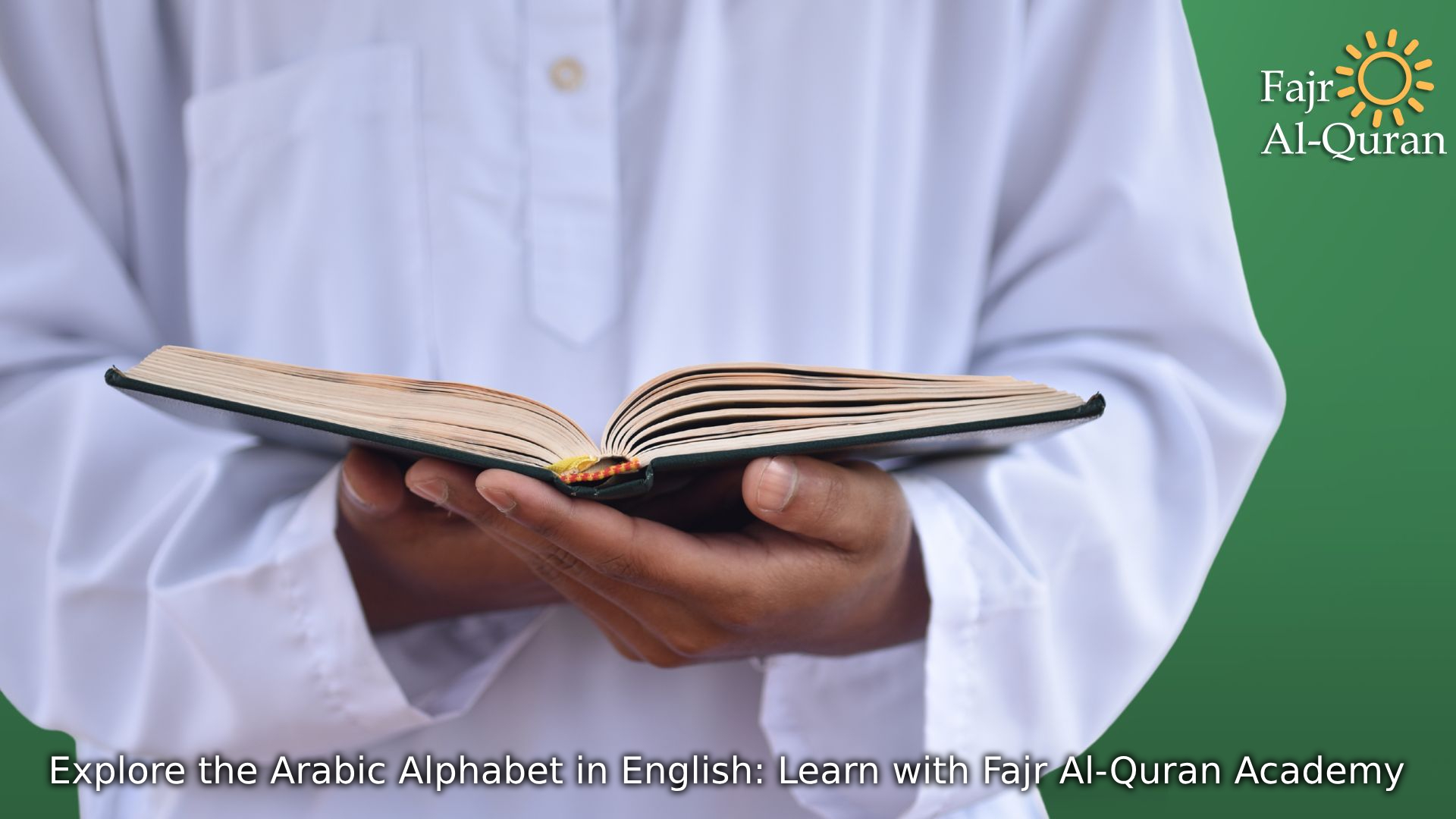
Arabic alphabet in Phrases
Learning individual letters with the Arabic Alphabet in English is essential,
But seeing them in actual words and phrases helps reinforce recognition and understanding.
Written Arabic Alphabet in English in Phrases, for example:
السلام عليكم – As-salamu alaykum (Peace be upon you)
مرحبا – Marhaban (Hello)
أهلا وسهلا – Ahlan wa sahlan (Welcome)
Each of these phrases includes alphabet letters like Alif, Laam, Seen, and Meem.
Fajr Al-Quran Academy uses interactive exercises and Qaida Noorania lessons.
That includes common phrases and translation, aiding in practical language use and pronunciation improvement.
How to Write Arabic in English Letters?
For those not yet comfortable with the Arabic script, many learners start by writing Arabic using English letters, a system often called Arabizi or Franco Arabic. This method uses the Latin alphabet.
7 represents Haa (ح)
3 represents Ain (ع)
5 or 7’ represents Khaa (خ)
2 represents Hamza (ء)
For example:
Ana 7abibak = أنا حبيبك (I am your beloved)
3arabi mush sa3b = العربي مش صعب (Arabic is not hard)
While Arabizi is informal, it can be a useful step for beginners before transitioning into the original Arabic form.
Fajr Al-Quran Academy offers courses that include structured guidance on moving from transliteration to actual Arabic writing.

Learn Arabic Alphabet: A to Z
For English speakers, the phrase “Arabic alphabet with English A to Z” means learning the Arabic letters from start to finish, or Alif to Yaa.
This complete set Arabic alphabet in English includes:
Alif (ا)
Baa (ب)
Ta (ت)
Thaa (ث)
Jeem (ج)
Haa (ح)
Khaa (خ)
Daal (د)
Dhaal (ذ)
Raa (ر)
Zay (ز)
Seen (س)
Sheen (ش)
Saad (ص)
Daad (ض)
Taa (ط)
Zaa (ظ)
Ain (ع)
Ghain (غ)
Faa (ف)
Qaaf (ق)
Kaaf (ك)
Laam (ل)
Meem (م)
Noon (ن)
Haa (ه)
Waaw (و)
Yaa (ي)
Each character has a specific sound, structure, and position-based form, which makes Arabic one of the most artistic scripts in the world.
Since the Arabic fonts are cursive by nature, all letters (except a few) connect in a word.
Fajr Al-Quran Academy teaches students how to recognize, connect, and write each letter.
Learn to speak the Arabic language through detailed visual lessons and typing exercises.
Arabic Letters in Phrases with Transliteration.
The Arabic alphabet in English in phrases with transliteration is a helpful tool for English learners.
To pronounce Arabic words accurately without reading the written script.
Since Arabic consists mainly of consonants, using spoken words bridges the gap between the Arabic alphabet and the English alphabet.
Words like Hamza (ء) and اكتب (uktub – write) are commonly seen in chat or Franco style, where learners type Arabic using Latin fonts.
This method is widely used when an Arabic keyboard is unavailable, especially in informal settings.
The cursive nature of Arabic Alphabet letters makes it look different across fonts.
So, learning to toggle between font styles and recognizing names or words in both scripts helps reinforce understanding.
At Fajr Al-Quran Academy, every lesson includes a translation sheet and practice words.
This format is considered effective, with a high rating from learners.
It’s closely aligned with how Gaelic learners approach their language, making Arabic more accessible for all.
Arabic Alphabet with English Letters.
The Arabic alphabet is written from right to left; each letter can appear differently depending on its position.
While some sounds, such as ب (B), ت (T), and م (M), resemble their English counterparts, others have no direct equivalent, making them challenging for English speakers to pronounce.
For example, ح (Hà) and ع (‘Ain) are guttural sounds produced deep in the throat, while خ (Kh) resembles the “ch” in “Bach.”
Letters like ض (Dhad) and ص (Sad) have emphatic pronunciations, adding complexity.
Transliterations help bridge the gap, such as representing ش as “Sh,” غ as “Gh,” and ق as “Q”—but these are only approximations.
Additionally, Arabic vowels (حركات, harakat) are often omitted in writing, requiring learners to infer the spoken from context.
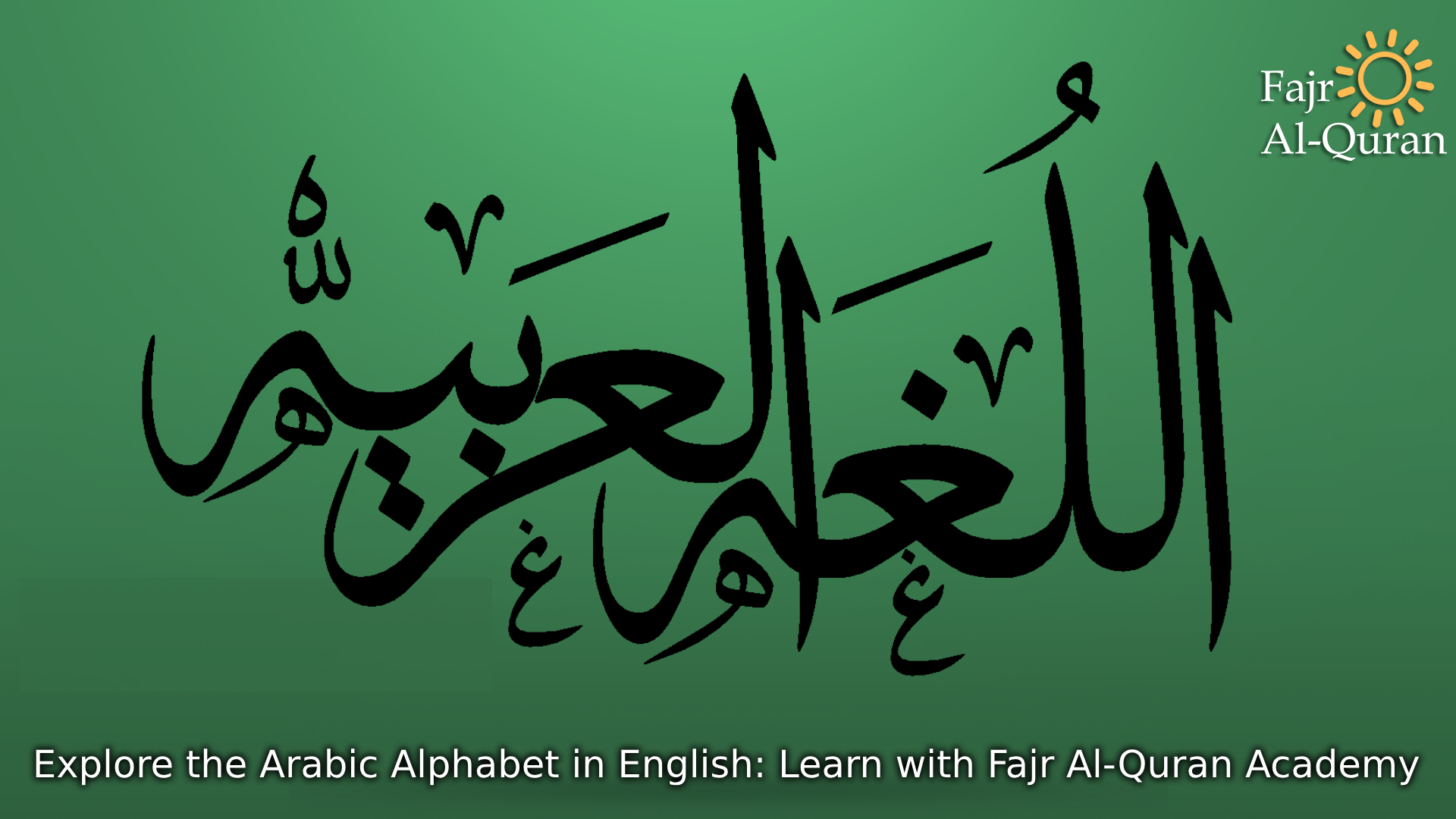
Learn to Speak Arabic with Fajr Al-Quran Academy
Fajr Al-Quran Academy has been rated as a leading platform for online Arabic learning because of its flexible and student-focused methodology.
Whether you’re just starting to learn the Arabic alphabet letters or you’re looking to build conversational fluency.
Offer the academy personalized lessons that fit every learning type.
Students can learn via:
One-on-one online classes to learn the Arabic Alphabet in English.
Structured Noorani Qaida courses
Interactive chat-based learning in Arabizi or Franco type
Real-time feedback on writing and translation.
With the best Arabic Quran Teacher Online, every student gets to type, speak, and write the alphabet in a style that works best for them.
This includes options for toggling between Roman letters and Arabic fonts or switching keyboard settings for Arabic typing practice.
Conclusion
Learning the Arabic alphabet in English is not just about memorizing characters—it’s about understanding a whole new language, its rules, and its unique style of expression.
From learning how to write using Latin letters to understanding the deep meaning behind each sound, students of Fajr Al-Quran Academy are equipped with the tools to speak Arabic confidently.
Whether you’re starting with basics, exploring Noorania Qaida lessons, or simply curious about how to say your name in Arabic.
This journey opens doors to the beauty of the Quran, Islamic traditions, and a growing connection with Arabic-speaking cultures.
Begin your step-by-step learning journey today with Fajr Al-Quran Academy.
Discover how easy and enjoyable it can be to learn the Arabic alphabet, all the way from Alif to Yaa.

